Nettavisen Online Newspaper: Value of Information Case Study Report
VerifiedAdded on 2022/11/18
|19
|5003
|176
Report
AI Summary
This report provides a comprehensive analysis of the Nettavisen case study, a Norwegian online startup that experienced significant growth after the 2009 financial crisis. The study focuses on the value of information within a data-driven business model (DDBM) and the challenges faced by digital media frontrunners. The report explores the business problem, business and IT alignment, and identifies three alternatives for Nettavisen: Software as a Service (SaaS), IoT Smart Retail, and Data as a Service (DaaS). It then analyzes these alternatives based on feasibility, benefits, costs, and risks, recommending the best choice and outlining an implementation plan. The report aims to provide insights into how Nettavisen can leverage data analytics to compete with legacy news publishers and new media players like Google and Facebook, emphasizing the importance of innovation, creativity, and effective data utilization.
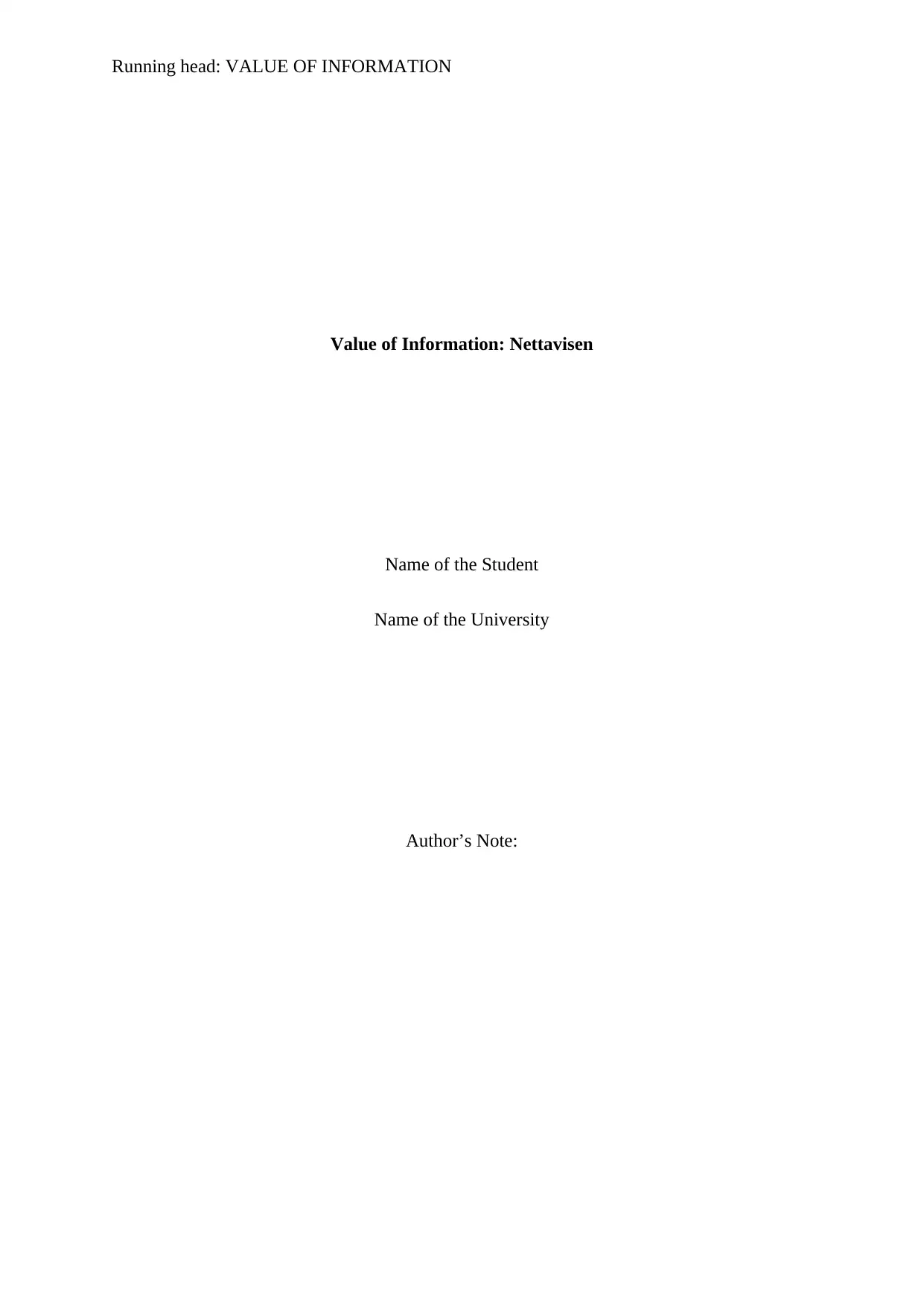
Running head: VALUE OF INFORMATION
Value of Information: Nettavisen
Name of the Student
Name of the University
Author’s Note:
Value of Information: Nettavisen
Name of the Student
Name of the University
Author’s Note:
Paraphrase This Document
Need a fresh take? Get an instant paraphrase of this document with our AI Paraphraser
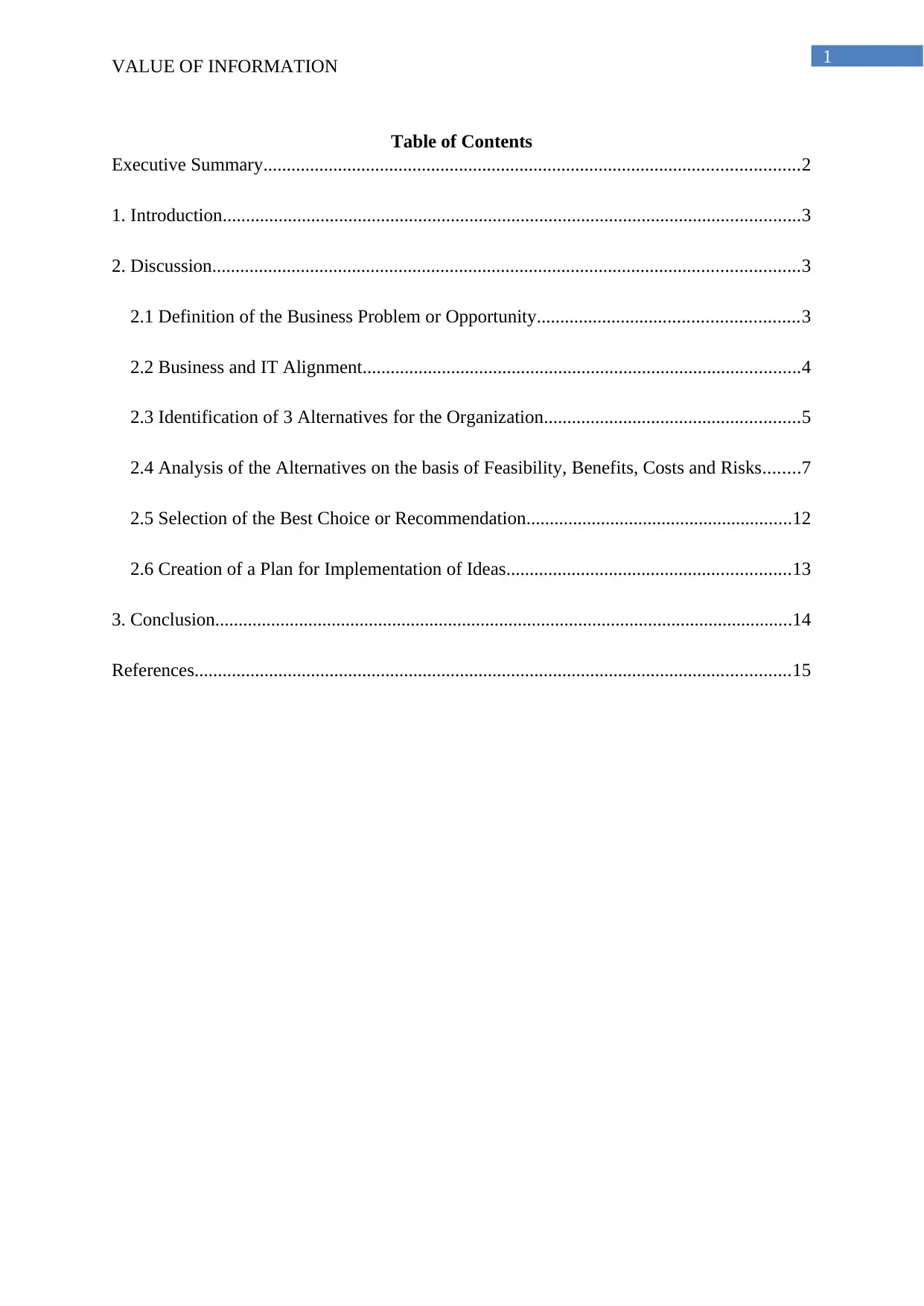
1
VALUE OF INFORMATION
Table of Contents
Executive Summary...................................................................................................................2
1. Introduction............................................................................................................................3
2. Discussion..............................................................................................................................3
2.1 Definition of the Business Problem or Opportunity........................................................3
2.2 Business and IT Alignment..............................................................................................4
2.3 Identification of 3 Alternatives for the Organization.......................................................5
2.4 Analysis of the Alternatives on the basis of Feasibility, Benefits, Costs and Risks........7
2.5 Selection of the Best Choice or Recommendation.........................................................12
2.6 Creation of a Plan for Implementation of Ideas.............................................................13
3. Conclusion............................................................................................................................14
References................................................................................................................................15
VALUE OF INFORMATION
Table of Contents
Executive Summary...................................................................................................................2
1. Introduction............................................................................................................................3
2. Discussion..............................................................................................................................3
2.1 Definition of the Business Problem or Opportunity........................................................3
2.2 Business and IT Alignment..............................................................................................4
2.3 Identification of 3 Alternatives for the Organization.......................................................5
2.4 Analysis of the Alternatives on the basis of Feasibility, Benefits, Costs and Risks........7
2.5 Selection of the Best Choice or Recommendation.........................................................12
2.6 Creation of a Plan for Implementation of Ideas.............................................................13
3. Conclusion............................................................................................................................14
References................................................................................................................................15
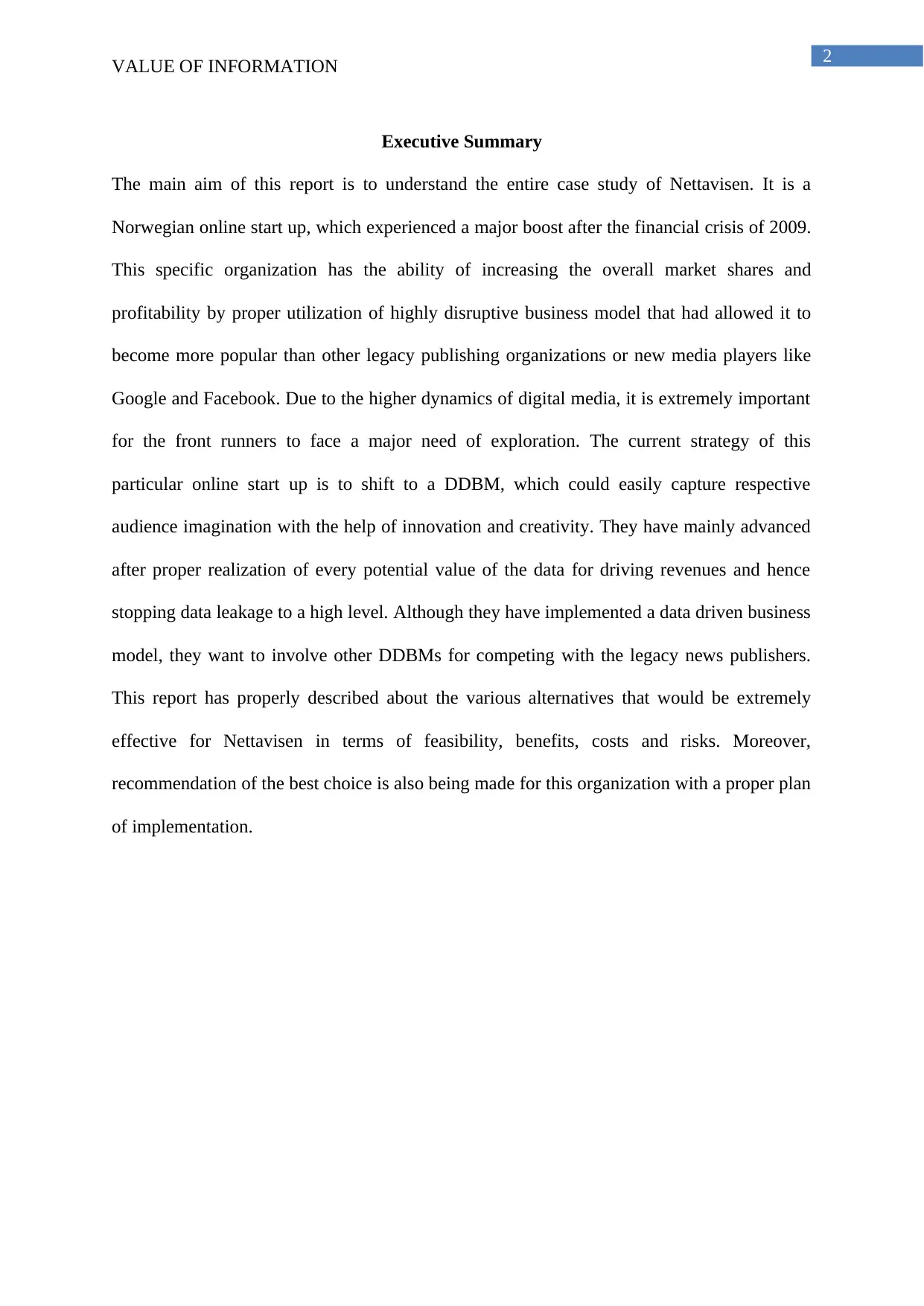
2
VALUE OF INFORMATION
Executive Summary
The main aim of this report is to understand the entire case study of Nettavisen. It is a
Norwegian online start up, which experienced a major boost after the financial crisis of 2009.
This specific organization has the ability of increasing the overall market shares and
profitability by proper utilization of highly disruptive business model that had allowed it to
become more popular than other legacy publishing organizations or new media players like
Google and Facebook. Due to the higher dynamics of digital media, it is extremely important
for the front runners to face a major need of exploration. The current strategy of this
particular online start up is to shift to a DDBM, which could easily capture respective
audience imagination with the help of innovation and creativity. They have mainly advanced
after proper realization of every potential value of the data for driving revenues and hence
stopping data leakage to a high level. Although they have implemented a data driven business
model, they want to involve other DDBMs for competing with the legacy news publishers.
This report has properly described about the various alternatives that would be extremely
effective for Nettavisen in terms of feasibility, benefits, costs and risks. Moreover,
recommendation of the best choice is also being made for this organization with a proper plan
of implementation.
VALUE OF INFORMATION
Executive Summary
The main aim of this report is to understand the entire case study of Nettavisen. It is a
Norwegian online start up, which experienced a major boost after the financial crisis of 2009.
This specific organization has the ability of increasing the overall market shares and
profitability by proper utilization of highly disruptive business model that had allowed it to
become more popular than other legacy publishing organizations or new media players like
Google and Facebook. Due to the higher dynamics of digital media, it is extremely important
for the front runners to face a major need of exploration. The current strategy of this
particular online start up is to shift to a DDBM, which could easily capture respective
audience imagination with the help of innovation and creativity. They have mainly advanced
after proper realization of every potential value of the data for driving revenues and hence
stopping data leakage to a high level. Although they have implemented a data driven business
model, they want to involve other DDBMs for competing with the legacy news publishers.
This report has properly described about the various alternatives that would be extremely
effective for Nettavisen in terms of feasibility, benefits, costs and risks. Moreover,
recommendation of the best choice is also being made for this organization with a proper plan
of implementation.
⊘ This is a preview!⊘
Do you want full access?
Subscribe today to unlock all pages.

Trusted by 1+ million students worldwide
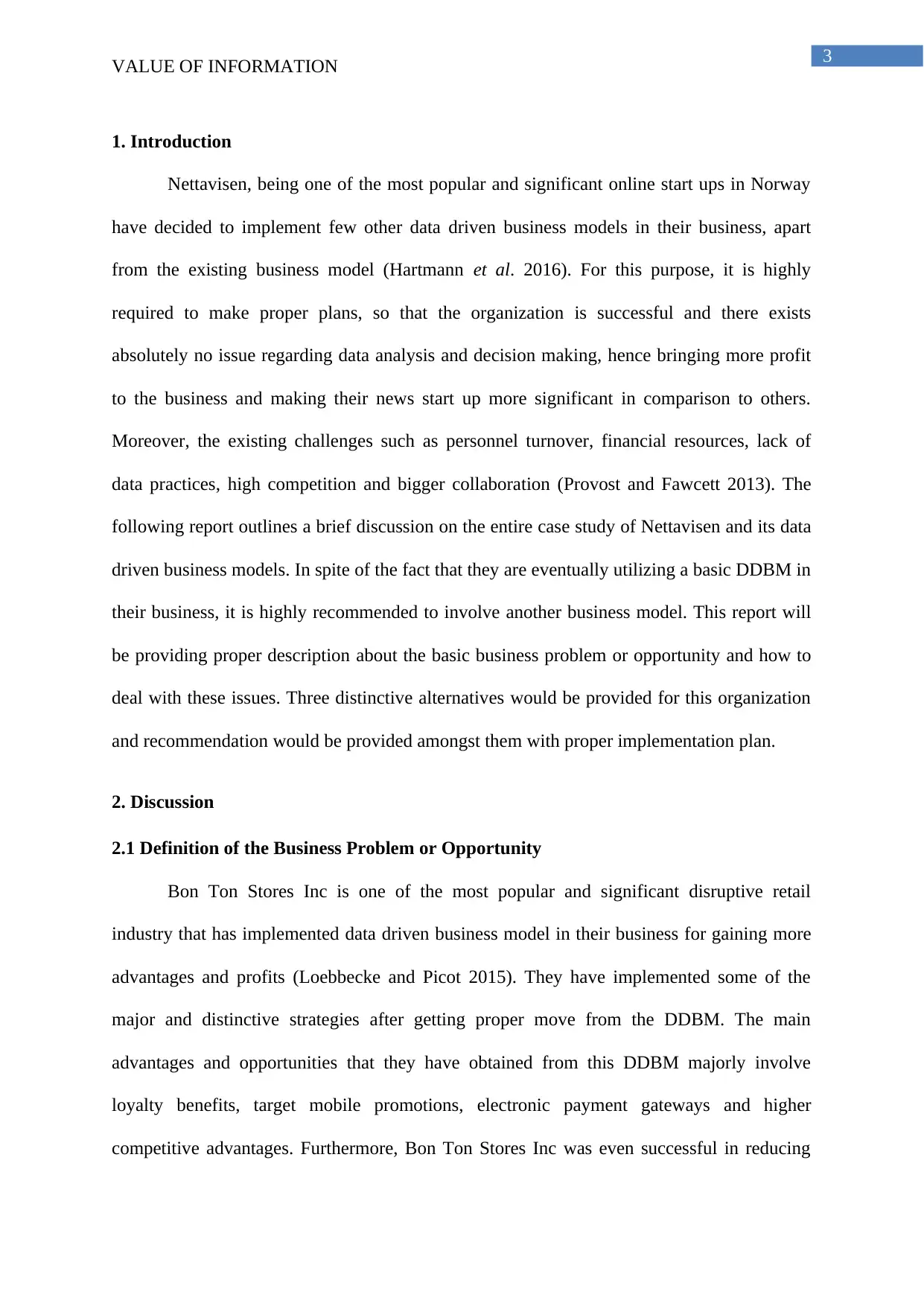
3
VALUE OF INFORMATION
1. Introduction
Nettavisen, being one of the most popular and significant online start ups in Norway
have decided to implement few other data driven business models in their business, apart
from the existing business model (Hartmann et al. 2016). For this purpose, it is highly
required to make proper plans, so that the organization is successful and there exists
absolutely no issue regarding data analysis and decision making, hence bringing more profit
to the business and making their news start up more significant in comparison to others.
Moreover, the existing challenges such as personnel turnover, financial resources, lack of
data practices, high competition and bigger collaboration (Provost and Fawcett 2013). The
following report outlines a brief discussion on the entire case study of Nettavisen and its data
driven business models. In spite of the fact that they are eventually utilizing a basic DDBM in
their business, it is highly recommended to involve another business model. This report will
be providing proper description about the basic business problem or opportunity and how to
deal with these issues. Three distinctive alternatives would be provided for this organization
and recommendation would be provided amongst them with proper implementation plan.
2. Discussion
2.1 Definition of the Business Problem or Opportunity
Bon Ton Stores Inc is one of the most popular and significant disruptive retail
industry that has implemented data driven business model in their business for gaining more
advantages and profits (Loebbecke and Picot 2015). They have implemented some of the
major and distinctive strategies after getting proper move from the DDBM. The main
advantages and opportunities that they have obtained from this DDBM majorly involve
loyalty benefits, target mobile promotions, electronic payment gateways and higher
competitive advantages. Furthermore, Bon Ton Stores Inc was even successful in reducing
VALUE OF INFORMATION
1. Introduction
Nettavisen, being one of the most popular and significant online start ups in Norway
have decided to implement few other data driven business models in their business, apart
from the existing business model (Hartmann et al. 2016). For this purpose, it is highly
required to make proper plans, so that the organization is successful and there exists
absolutely no issue regarding data analysis and decision making, hence bringing more profit
to the business and making their news start up more significant in comparison to others.
Moreover, the existing challenges such as personnel turnover, financial resources, lack of
data practices, high competition and bigger collaboration (Provost and Fawcett 2013). The
following report outlines a brief discussion on the entire case study of Nettavisen and its data
driven business models. In spite of the fact that they are eventually utilizing a basic DDBM in
their business, it is highly recommended to involve another business model. This report will
be providing proper description about the basic business problem or opportunity and how to
deal with these issues. Three distinctive alternatives would be provided for this organization
and recommendation would be provided amongst them with proper implementation plan.
2. Discussion
2.1 Definition of the Business Problem or Opportunity
Bon Ton Stores Inc is one of the most popular and significant disruptive retail
industry that has implemented data driven business model in their business for gaining more
advantages and profits (Loebbecke and Picot 2015). They have implemented some of the
major and distinctive strategies after getting proper move from the DDBM. The main
advantages and opportunities that they have obtained from this DDBM majorly involve
loyalty benefits, target mobile promotions, electronic payment gateways and higher
competitive advantages. Furthermore, Bon Ton Stores Inc was even successful in reducing
Paraphrase This Document
Need a fresh take? Get an instant paraphrase of this document with our AI Paraphraser
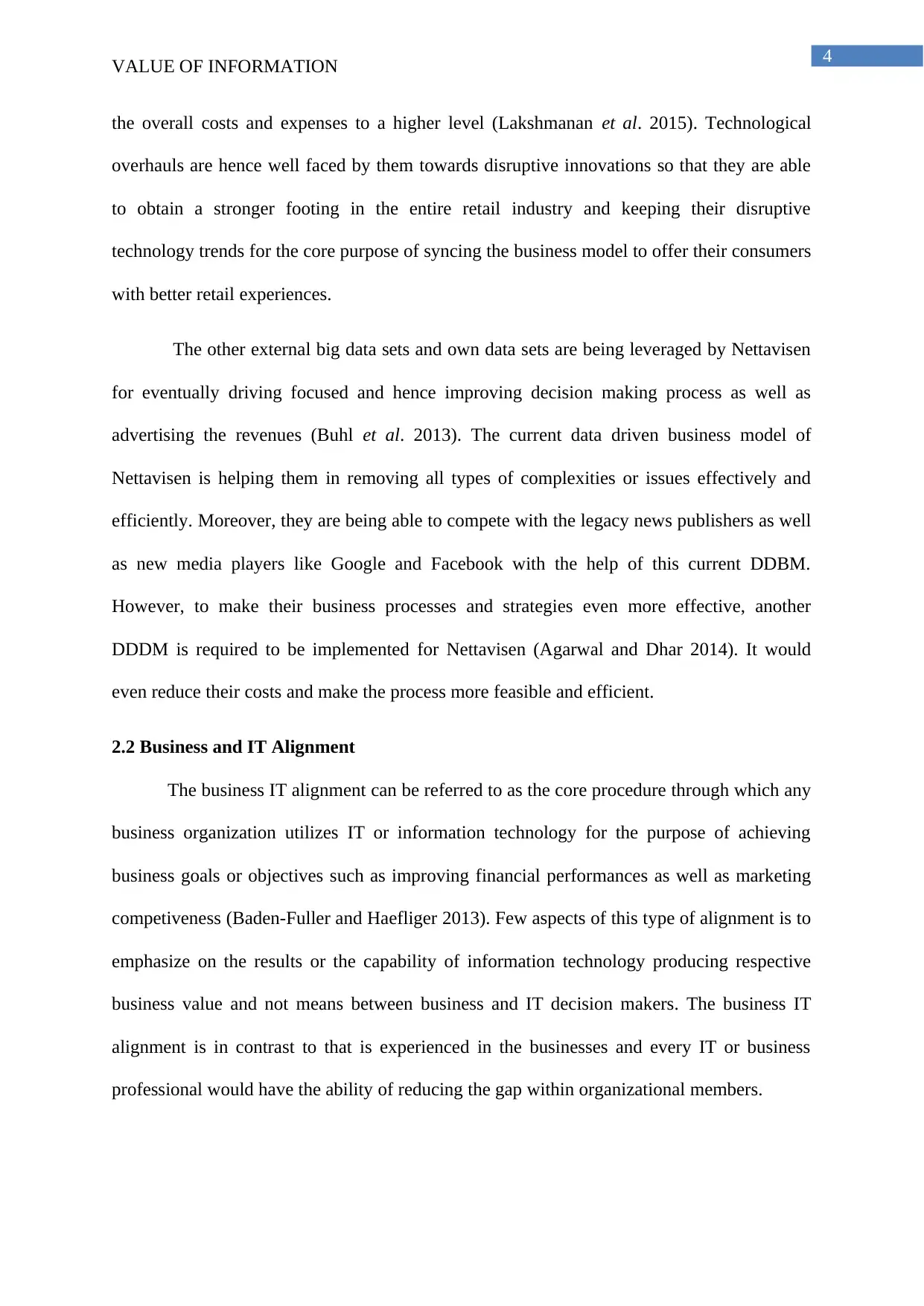
4
VALUE OF INFORMATION
the overall costs and expenses to a higher level (Lakshmanan et al. 2015). Technological
overhauls are hence well faced by them towards disruptive innovations so that they are able
to obtain a stronger footing in the entire retail industry and keeping their disruptive
technology trends for the core purpose of syncing the business model to offer their consumers
with better retail experiences.
The other external big data sets and own data sets are being leveraged by Nettavisen
for eventually driving focused and hence improving decision making process as well as
advertising the revenues (Buhl et al. 2013). The current data driven business model of
Nettavisen is helping them in removing all types of complexities or issues effectively and
efficiently. Moreover, they are being able to compete with the legacy news publishers as well
as new media players like Google and Facebook with the help of this current DDBM.
However, to make their business processes and strategies even more effective, another
DDDM is required to be implemented for Nettavisen (Agarwal and Dhar 2014). It would
even reduce their costs and make the process more feasible and efficient.
2.2 Business and IT Alignment
The business IT alignment can be referred to as the core procedure through which any
business organization utilizes IT or information technology for the purpose of achieving
business goals or objectives such as improving financial performances as well as marketing
competiveness (Baden-Fuller and Haefliger 2013). Few aspects of this type of alignment is to
emphasize on the results or the capability of information technology producing respective
business value and not means between business and IT decision makers. The business IT
alignment is in contrast to that is experienced in the businesses and every IT or business
professional would have the ability of reducing the gap within organizational members.
VALUE OF INFORMATION
the overall costs and expenses to a higher level (Lakshmanan et al. 2015). Technological
overhauls are hence well faced by them towards disruptive innovations so that they are able
to obtain a stronger footing in the entire retail industry and keeping their disruptive
technology trends for the core purpose of syncing the business model to offer their consumers
with better retail experiences.
The other external big data sets and own data sets are being leveraged by Nettavisen
for eventually driving focused and hence improving decision making process as well as
advertising the revenues (Buhl et al. 2013). The current data driven business model of
Nettavisen is helping them in removing all types of complexities or issues effectively and
efficiently. Moreover, they are being able to compete with the legacy news publishers as well
as new media players like Google and Facebook with the help of this current DDBM.
However, to make their business processes and strategies even more effective, another
DDDM is required to be implemented for Nettavisen (Agarwal and Dhar 2014). It would
even reduce their costs and make the process more feasible and efficient.
2.2 Business and IT Alignment
The business IT alignment can be referred to as the core procedure through which any
business organization utilizes IT or information technology for the purpose of achieving
business goals or objectives such as improving financial performances as well as marketing
competiveness (Baden-Fuller and Haefliger 2013). Few aspects of this type of alignment is to
emphasize on the results or the capability of information technology producing respective
business value and not means between business and IT decision makers. The business IT
alignment is in contrast to that is experienced in the businesses and every IT or business
professional would have the ability of reducing the gap within organizational members.
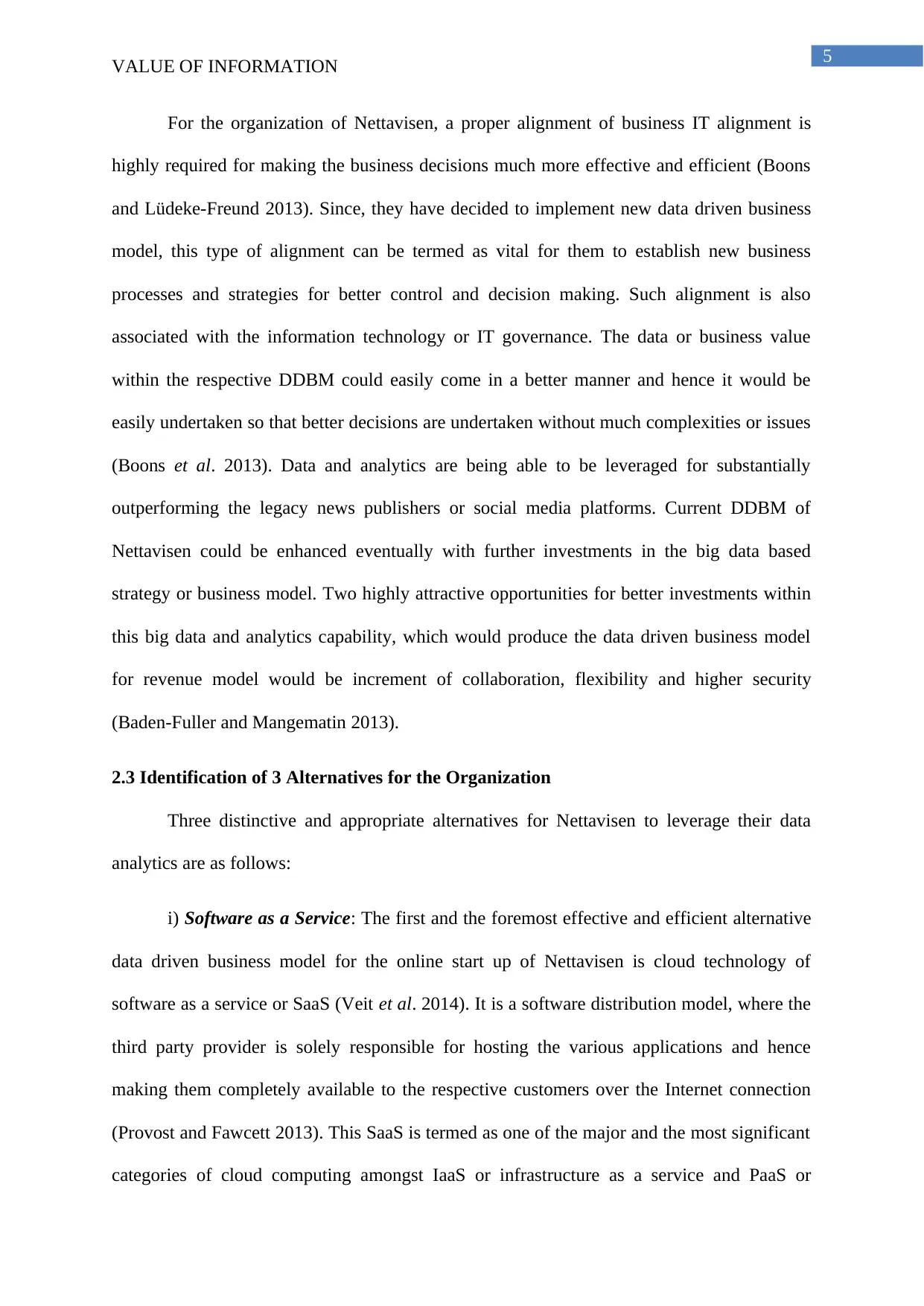
5
VALUE OF INFORMATION
For the organization of Nettavisen, a proper alignment of business IT alignment is
highly required for making the business decisions much more effective and efficient (Boons
and Lüdeke-Freund 2013). Since, they have decided to implement new data driven business
model, this type of alignment can be termed as vital for them to establish new business
processes and strategies for better control and decision making. Such alignment is also
associated with the information technology or IT governance. The data or business value
within the respective DDBM could easily come in a better manner and hence it would be
easily undertaken so that better decisions are undertaken without much complexities or issues
(Boons et al. 2013). Data and analytics are being able to be leveraged for substantially
outperforming the legacy news publishers or social media platforms. Current DDBM of
Nettavisen could be enhanced eventually with further investments in the big data based
strategy or business model. Two highly attractive opportunities for better investments within
this big data and analytics capability, which would produce the data driven business model
for revenue model would be increment of collaboration, flexibility and higher security
(Baden-Fuller and Mangematin 2013).
2.3 Identification of 3 Alternatives for the Organization
Three distinctive and appropriate alternatives for Nettavisen to leverage their data
analytics are as follows:
i) Software as a Service: The first and the foremost effective and efficient alternative
data driven business model for the online start up of Nettavisen is cloud technology of
software as a service or SaaS (Veit et al. 2014). It is a software distribution model, where the
third party provider is solely responsible for hosting the various applications and hence
making them completely available to the respective customers over the Internet connection
(Provost and Fawcett 2013). This SaaS is termed as one of the major and the most significant
categories of cloud computing amongst IaaS or infrastructure as a service and PaaS or
VALUE OF INFORMATION
For the organization of Nettavisen, a proper alignment of business IT alignment is
highly required for making the business decisions much more effective and efficient (Boons
and Lüdeke-Freund 2013). Since, they have decided to implement new data driven business
model, this type of alignment can be termed as vital for them to establish new business
processes and strategies for better control and decision making. Such alignment is also
associated with the information technology or IT governance. The data or business value
within the respective DDBM could easily come in a better manner and hence it would be
easily undertaken so that better decisions are undertaken without much complexities or issues
(Boons et al. 2013). Data and analytics are being able to be leveraged for substantially
outperforming the legacy news publishers or social media platforms. Current DDBM of
Nettavisen could be enhanced eventually with further investments in the big data based
strategy or business model. Two highly attractive opportunities for better investments within
this big data and analytics capability, which would produce the data driven business model
for revenue model would be increment of collaboration, flexibility and higher security
(Baden-Fuller and Mangematin 2013).
2.3 Identification of 3 Alternatives for the Organization
Three distinctive and appropriate alternatives for Nettavisen to leverage their data
analytics are as follows:
i) Software as a Service: The first and the foremost effective and efficient alternative
data driven business model for the online start up of Nettavisen is cloud technology of
software as a service or SaaS (Veit et al. 2014). It is a software distribution model, where the
third party provider is solely responsible for hosting the various applications and hence
making them completely available to the respective customers over the Internet connection
(Provost and Fawcett 2013). This SaaS is termed as one of the major and the most significant
categories of cloud computing amongst IaaS or infrastructure as a service and PaaS or
⊘ This is a preview!⊘
Do you want full access?
Subscribe today to unlock all pages.

Trusted by 1+ million students worldwide
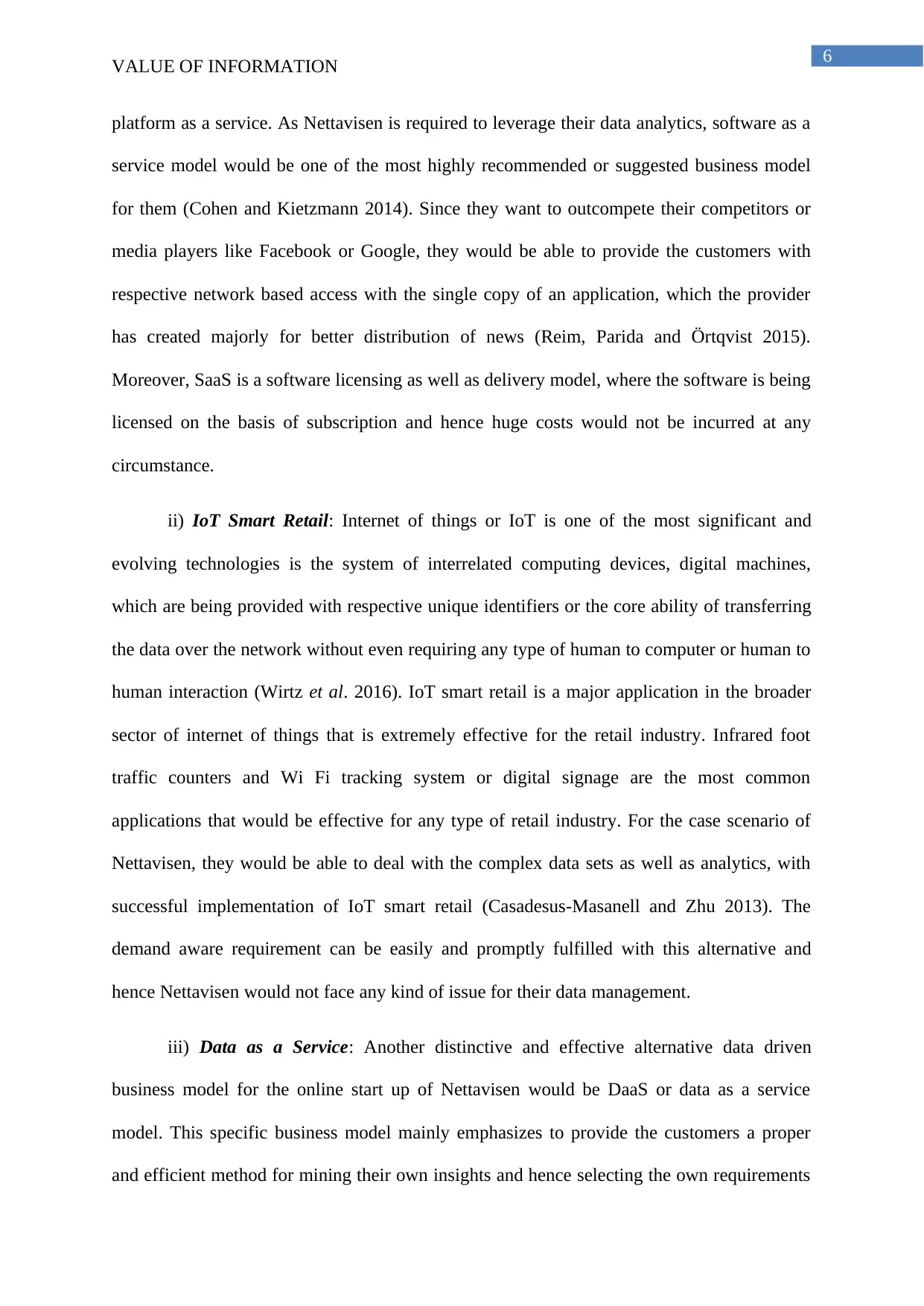
6
VALUE OF INFORMATION
platform as a service. As Nettavisen is required to leverage their data analytics, software as a
service model would be one of the most highly recommended or suggested business model
for them (Cohen and Kietzmann 2014). Since they want to outcompete their competitors or
media players like Facebook or Google, they would be able to provide the customers with
respective network based access with the single copy of an application, which the provider
has created majorly for better distribution of news (Reim, Parida and Örtqvist 2015).
Moreover, SaaS is a software licensing as well as delivery model, where the software is being
licensed on the basis of subscription and hence huge costs would not be incurred at any
circumstance.
ii) IoT Smart Retail: Internet of things or IoT is one of the most significant and
evolving technologies is the system of interrelated computing devices, digital machines,
which are being provided with respective unique identifiers or the core ability of transferring
the data over the network without even requiring any type of human to computer or human to
human interaction (Wirtz et al. 2016). IoT smart retail is a major application in the broader
sector of internet of things that is extremely effective for the retail industry. Infrared foot
traffic counters and Wi Fi tracking system or digital signage are the most common
applications that would be effective for any type of retail industry. For the case scenario of
Nettavisen, they would be able to deal with the complex data sets as well as analytics, with
successful implementation of IoT smart retail (Casadesus‐Masanell and Zhu 2013). The
demand aware requirement can be easily and promptly fulfilled with this alternative and
hence Nettavisen would not face any kind of issue for their data management.
iii) Data as a Service: Another distinctive and effective alternative data driven
business model for the online start up of Nettavisen would be DaaS or data as a service
model. This specific business model mainly emphasizes to provide the customers a proper
and efficient method for mining their own insights and hence selecting the own requirements
VALUE OF INFORMATION
platform as a service. As Nettavisen is required to leverage their data analytics, software as a
service model would be one of the most highly recommended or suggested business model
for them (Cohen and Kietzmann 2014). Since they want to outcompete their competitors or
media players like Facebook or Google, they would be able to provide the customers with
respective network based access with the single copy of an application, which the provider
has created majorly for better distribution of news (Reim, Parida and Örtqvist 2015).
Moreover, SaaS is a software licensing as well as delivery model, where the software is being
licensed on the basis of subscription and hence huge costs would not be incurred at any
circumstance.
ii) IoT Smart Retail: Internet of things or IoT is one of the most significant and
evolving technologies is the system of interrelated computing devices, digital machines,
which are being provided with respective unique identifiers or the core ability of transferring
the data over the network without even requiring any type of human to computer or human to
human interaction (Wirtz et al. 2016). IoT smart retail is a major application in the broader
sector of internet of things that is extremely effective for the retail industry. Infrared foot
traffic counters and Wi Fi tracking system or digital signage are the most common
applications that would be effective for any type of retail industry. For the case scenario of
Nettavisen, they would be able to deal with the complex data sets as well as analytics, with
successful implementation of IoT smart retail (Casadesus‐Masanell and Zhu 2013). The
demand aware requirement can be easily and promptly fulfilled with this alternative and
hence Nettavisen would not face any kind of issue for their data management.
iii) Data as a Service: Another distinctive and effective alternative data driven
business model for the online start up of Nettavisen would be DaaS or data as a service
model. This specific business model mainly emphasizes to provide the customers a proper
and efficient method for mining their own insights and hence selecting the own requirements
Paraphrase This Document
Need a fresh take? Get an instant paraphrase of this document with our AI Paraphraser
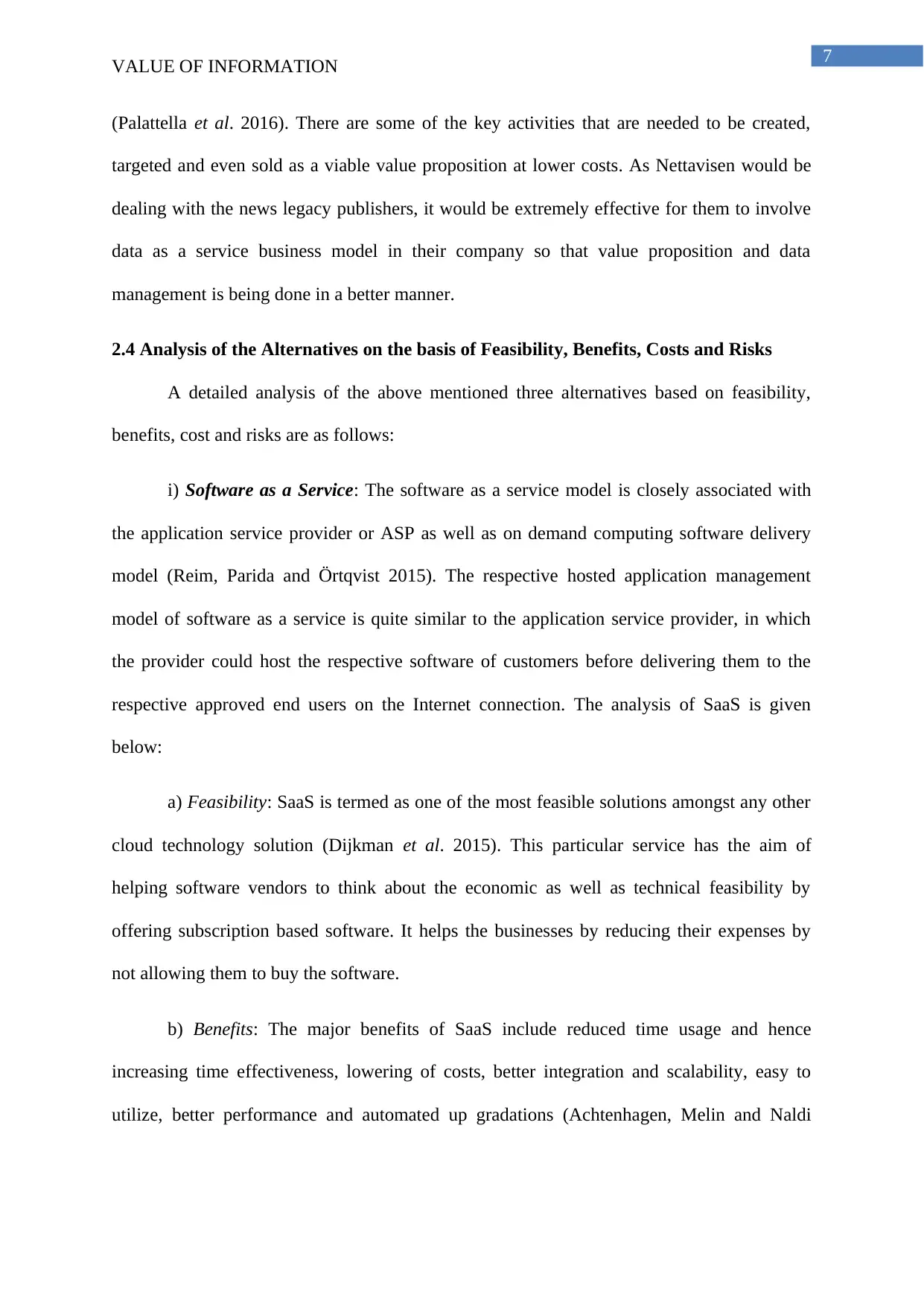
7
VALUE OF INFORMATION
(Palattella et al. 2016). There are some of the key activities that are needed to be created,
targeted and even sold as a viable value proposition at lower costs. As Nettavisen would be
dealing with the news legacy publishers, it would be extremely effective for them to involve
data as a service business model in their company so that value proposition and data
management is being done in a better manner.
2.4 Analysis of the Alternatives on the basis of Feasibility, Benefits, Costs and Risks
A detailed analysis of the above mentioned three alternatives based on feasibility,
benefits, cost and risks are as follows:
i) Software as a Service: The software as a service model is closely associated with
the application service provider or ASP as well as on demand computing software delivery
model (Reim, Parida and Örtqvist 2015). The respective hosted application management
model of software as a service is quite similar to the application service provider, in which
the provider could host the respective software of customers before delivering them to the
respective approved end users on the Internet connection. The analysis of SaaS is given
below:
a) Feasibility: SaaS is termed as one of the most feasible solutions amongst any other
cloud technology solution (Dijkman et al. 2015). This particular service has the aim of
helping software vendors to think about the economic as well as technical feasibility by
offering subscription based software. It helps the businesses by reducing their expenses by
not allowing them to buy the software.
b) Benefits: The major benefits of SaaS include reduced time usage and hence
increasing time effectiveness, lowering of costs, better integration and scalability, easy to
utilize, better performance and automated up gradations (Achtenhagen, Melin and Naldi
VALUE OF INFORMATION
(Palattella et al. 2016). There are some of the key activities that are needed to be created,
targeted and even sold as a viable value proposition at lower costs. As Nettavisen would be
dealing with the news legacy publishers, it would be extremely effective for them to involve
data as a service business model in their company so that value proposition and data
management is being done in a better manner.
2.4 Analysis of the Alternatives on the basis of Feasibility, Benefits, Costs and Risks
A detailed analysis of the above mentioned three alternatives based on feasibility,
benefits, cost and risks are as follows:
i) Software as a Service: The software as a service model is closely associated with
the application service provider or ASP as well as on demand computing software delivery
model (Reim, Parida and Örtqvist 2015). The respective hosted application management
model of software as a service is quite similar to the application service provider, in which
the provider could host the respective software of customers before delivering them to the
respective approved end users on the Internet connection. The analysis of SaaS is given
below:
a) Feasibility: SaaS is termed as one of the most feasible solutions amongst any other
cloud technology solution (Dijkman et al. 2015). This particular service has the aim of
helping software vendors to think about the economic as well as technical feasibility by
offering subscription based software. It helps the businesses by reducing their expenses by
not allowing them to buy the software.
b) Benefits: The major benefits of SaaS include reduced time usage and hence
increasing time effectiveness, lowering of costs, better integration and scalability, easy to
utilize, better performance and automated up gradations (Achtenhagen, Melin and Naldi
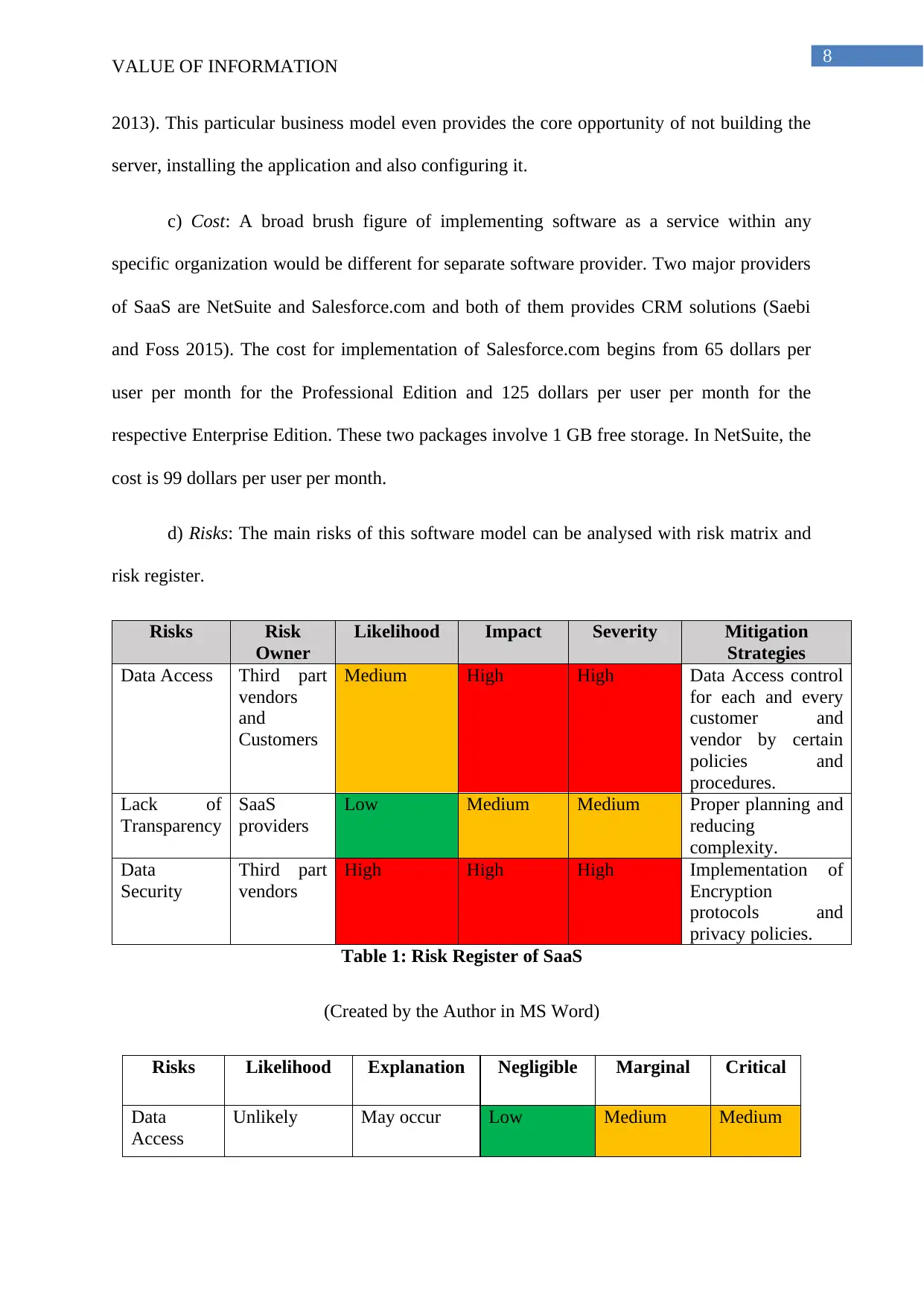
8
VALUE OF INFORMATION
2013). This particular business model even provides the core opportunity of not building the
server, installing the application and also configuring it.
c) Cost: A broad brush figure of implementing software as a service within any
specific organization would be different for separate software provider. Two major providers
of SaaS are NetSuite and Salesforce.com and both of them provides CRM solutions (Saebi
and Foss 2015). The cost for implementation of Salesforce.com begins from 65 dollars per
user per month for the Professional Edition and 125 dollars per user per month for the
respective Enterprise Edition. These two packages involve 1 GB free storage. In NetSuite, the
cost is 99 dollars per user per month.
d) Risks: The main risks of this software model can be analysed with risk matrix and
risk register.
Risks Risk
Owner
Likelihood Impact Severity Mitigation
Strategies
Data Access Third part
vendors
and
Customers
Medium High High Data Access control
for each and every
customer and
vendor by certain
policies and
procedures.
Lack of
Transparency
SaaS
providers
Low Medium Medium Proper planning and
reducing
complexity.
Data
Security
Third part
vendors
High High High Implementation of
Encryption
protocols and
privacy policies.
Table 1: Risk Register of SaaS
(Created by the Author in MS Word)
Risks Likelihood Explanation Negligible Marginal Critical
Data
Access
Unlikely May occur Low Medium Medium
VALUE OF INFORMATION
2013). This particular business model even provides the core opportunity of not building the
server, installing the application and also configuring it.
c) Cost: A broad brush figure of implementing software as a service within any
specific organization would be different for separate software provider. Two major providers
of SaaS are NetSuite and Salesforce.com and both of them provides CRM solutions (Saebi
and Foss 2015). The cost for implementation of Salesforce.com begins from 65 dollars per
user per month for the Professional Edition and 125 dollars per user per month for the
respective Enterprise Edition. These two packages involve 1 GB free storage. In NetSuite, the
cost is 99 dollars per user per month.
d) Risks: The main risks of this software model can be analysed with risk matrix and
risk register.
Risks Risk
Owner
Likelihood Impact Severity Mitigation
Strategies
Data Access Third part
vendors
and
Customers
Medium High High Data Access control
for each and every
customer and
vendor by certain
policies and
procedures.
Lack of
Transparency
SaaS
providers
Low Medium Medium Proper planning and
reducing
complexity.
Data
Security
Third part
vendors
High High High Implementation of
Encryption
protocols and
privacy policies.
Table 1: Risk Register of SaaS
(Created by the Author in MS Word)
Risks Likelihood Explanation Negligible Marginal Critical
Data
Access
Unlikely May occur Low Medium Medium
⊘ This is a preview!⊘
Do you want full access?
Subscribe today to unlock all pages.

Trusted by 1+ million students worldwide
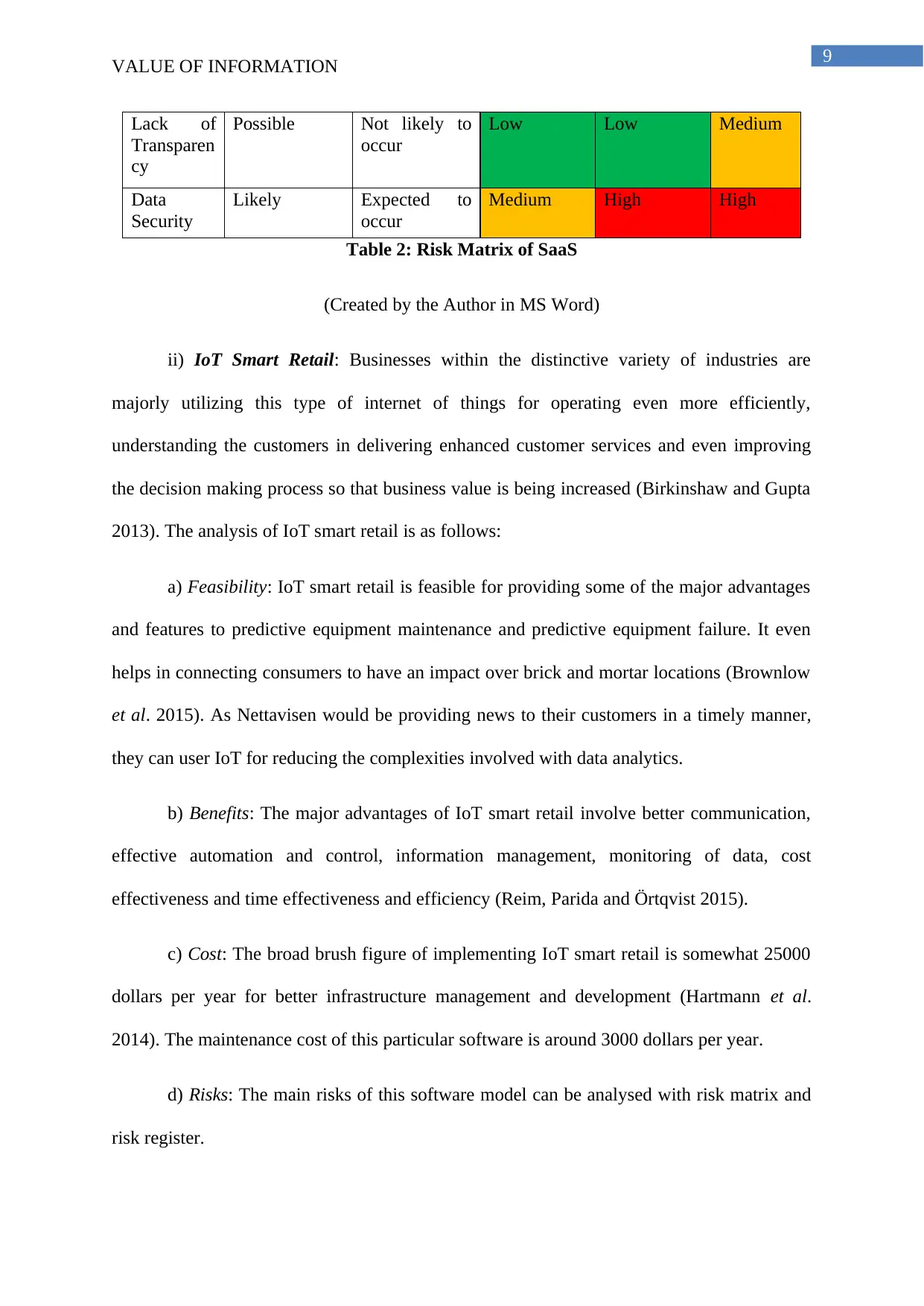
9
VALUE OF INFORMATION
Lack of
Transparen
cy
Possible Not likely to
occur
Low Low Medium
Data
Security
Likely Expected to
occur
Medium High High
Table 2: Risk Matrix of SaaS
(Created by the Author in MS Word)
ii) IoT Smart Retail: Businesses within the distinctive variety of industries are
majorly utilizing this type of internet of things for operating even more efficiently,
understanding the customers in delivering enhanced customer services and even improving
the decision making process so that business value is being increased (Birkinshaw and Gupta
2013). The analysis of IoT smart retail is as follows:
a) Feasibility: IoT smart retail is feasible for providing some of the major advantages
and features to predictive equipment maintenance and predictive equipment failure. It even
helps in connecting consumers to have an impact over brick and mortar locations (Brownlow
et al. 2015). As Nettavisen would be providing news to their customers in a timely manner,
they can user IoT for reducing the complexities involved with data analytics.
b) Benefits: The major advantages of IoT smart retail involve better communication,
effective automation and control, information management, monitoring of data, cost
effectiveness and time effectiveness and efficiency (Reim, Parida and Örtqvist 2015).
c) Cost: The broad brush figure of implementing IoT smart retail is somewhat 25000
dollars per year for better infrastructure management and development (Hartmann et al.
2014). The maintenance cost of this particular software is around 3000 dollars per year.
d) Risks: The main risks of this software model can be analysed with risk matrix and
risk register.
VALUE OF INFORMATION
Lack of
Transparen
cy
Possible Not likely to
occur
Low Low Medium
Data
Security
Likely Expected to
occur
Medium High High
Table 2: Risk Matrix of SaaS
(Created by the Author in MS Word)
ii) IoT Smart Retail: Businesses within the distinctive variety of industries are
majorly utilizing this type of internet of things for operating even more efficiently,
understanding the customers in delivering enhanced customer services and even improving
the decision making process so that business value is being increased (Birkinshaw and Gupta
2013). The analysis of IoT smart retail is as follows:
a) Feasibility: IoT smart retail is feasible for providing some of the major advantages
and features to predictive equipment maintenance and predictive equipment failure. It even
helps in connecting consumers to have an impact over brick and mortar locations (Brownlow
et al. 2015). As Nettavisen would be providing news to their customers in a timely manner,
they can user IoT for reducing the complexities involved with data analytics.
b) Benefits: The major advantages of IoT smart retail involve better communication,
effective automation and control, information management, monitoring of data, cost
effectiveness and time effectiveness and efficiency (Reim, Parida and Örtqvist 2015).
c) Cost: The broad brush figure of implementing IoT smart retail is somewhat 25000
dollars per year for better infrastructure management and development (Hartmann et al.
2014). The maintenance cost of this particular software is around 3000 dollars per year.
d) Risks: The main risks of this software model can be analysed with risk matrix and
risk register.
Paraphrase This Document
Need a fresh take? Get an instant paraphrase of this document with our AI Paraphraser
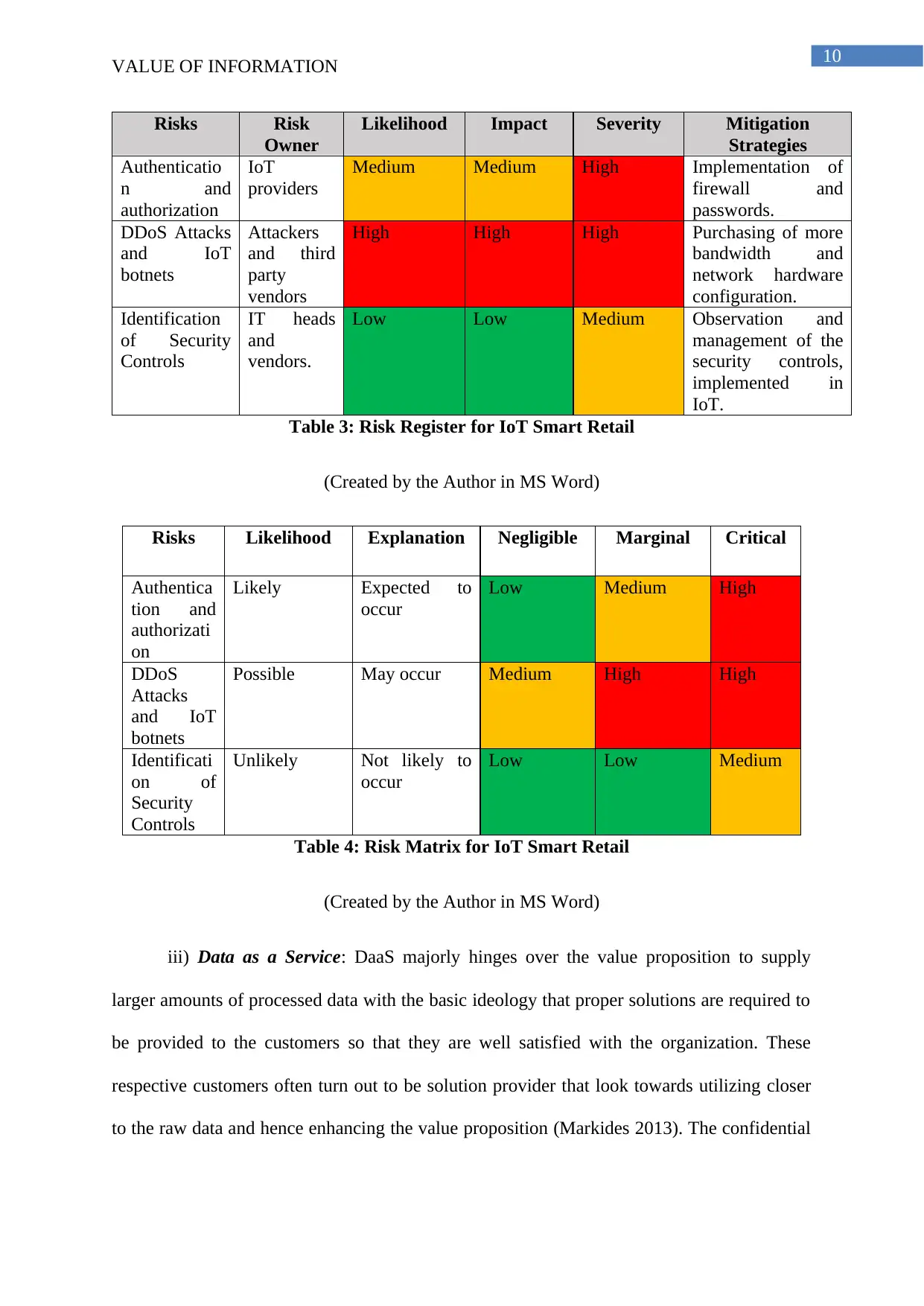
10
VALUE OF INFORMATION
Risks Risk
Owner
Likelihood Impact Severity Mitigation
Strategies
Authenticatio
n and
authorization
IoT
providers
Medium Medium High Implementation of
firewall and
passwords.
DDoS Attacks
and IoT
botnets
Attackers
and third
party
vendors
High High High Purchasing of more
bandwidth and
network hardware
configuration.
Identification
of Security
Controls
IT heads
and
vendors.
Low Low Medium Observation and
management of the
security controls,
implemented in
IoT.
Table 3: Risk Register for IoT Smart Retail
(Created by the Author in MS Word)
Risks Likelihood Explanation Negligible Marginal Critical
Authentica
tion and
authorizati
on
Likely Expected to
occur
Low Medium High
DDoS
Attacks
and IoT
botnets
Possible May occur Medium High High
Identificati
on of
Security
Controls
Unlikely Not likely to
occur
Low Low Medium
Table 4: Risk Matrix for IoT Smart Retail
(Created by the Author in MS Word)
iii) Data as a Service: DaaS majorly hinges over the value proposition to supply
larger amounts of processed data with the basic ideology that proper solutions are required to
be provided to the customers so that they are well satisfied with the organization. These
respective customers often turn out to be solution provider that look towards utilizing closer
to the raw data and hence enhancing the value proposition (Markides 2013). The confidential
VALUE OF INFORMATION
Risks Risk
Owner
Likelihood Impact Severity Mitigation
Strategies
Authenticatio
n and
authorization
IoT
providers
Medium Medium High Implementation of
firewall and
passwords.
DDoS Attacks
and IoT
botnets
Attackers
and third
party
vendors
High High High Purchasing of more
bandwidth and
network hardware
configuration.
Identification
of Security
Controls
IT heads
and
vendors.
Low Low Medium Observation and
management of the
security controls,
implemented in
IoT.
Table 3: Risk Register for IoT Smart Retail
(Created by the Author in MS Word)
Risks Likelihood Explanation Negligible Marginal Critical
Authentica
tion and
authorizati
on
Likely Expected to
occur
Low Medium High
DDoS
Attacks
and IoT
botnets
Possible May occur Medium High High
Identificati
on of
Security
Controls
Unlikely Not likely to
occur
Low Low Medium
Table 4: Risk Matrix for IoT Smart Retail
(Created by the Author in MS Word)
iii) Data as a Service: DaaS majorly hinges over the value proposition to supply
larger amounts of processed data with the basic ideology that proper solutions are required to
be provided to the customers so that they are well satisfied with the organization. These
respective customers often turn out to be solution provider that look towards utilizing closer
to the raw data and hence enhancing the value proposition (Markides 2013). The confidential
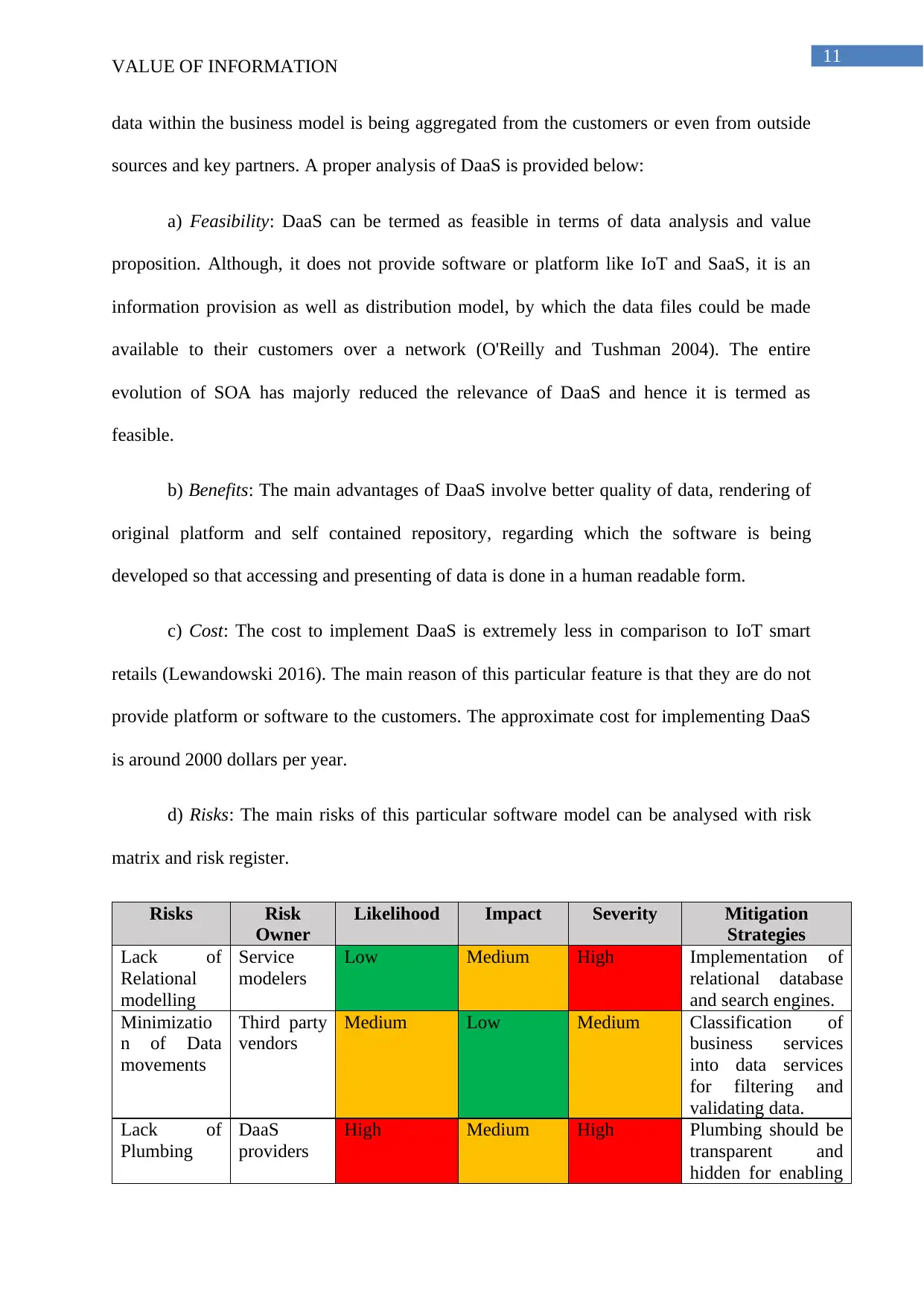
11
VALUE OF INFORMATION
data within the business model is being aggregated from the customers or even from outside
sources and key partners. A proper analysis of DaaS is provided below:
a) Feasibility: DaaS can be termed as feasible in terms of data analysis and value
proposition. Although, it does not provide software or platform like IoT and SaaS, it is an
information provision as well as distribution model, by which the data files could be made
available to their customers over a network (O'Reilly and Tushman 2004). The entire
evolution of SOA has majorly reduced the relevance of DaaS and hence it is termed as
feasible.
b) Benefits: The main advantages of DaaS involve better quality of data, rendering of
original platform and self contained repository, regarding which the software is being
developed so that accessing and presenting of data is done in a human readable form.
c) Cost: The cost to implement DaaS is extremely less in comparison to IoT smart
retails (Lewandowski 2016). The main reason of this particular feature is that they are do not
provide platform or software to the customers. The approximate cost for implementing DaaS
is around 2000 dollars per year.
d) Risks: The main risks of this particular software model can be analysed with risk
matrix and risk register.
Risks Risk
Owner
Likelihood Impact Severity Mitigation
Strategies
Lack of
Relational
modelling
Service
modelers
Low Medium High Implementation of
relational database
and search engines.
Minimizatio
n of Data
movements
Third party
vendors
Medium Low Medium Classification of
business services
into data services
for filtering and
validating data.
Lack of
Plumbing
DaaS
providers
High Medium High Plumbing should be
transparent and
hidden for enabling
VALUE OF INFORMATION
data within the business model is being aggregated from the customers or even from outside
sources and key partners. A proper analysis of DaaS is provided below:
a) Feasibility: DaaS can be termed as feasible in terms of data analysis and value
proposition. Although, it does not provide software or platform like IoT and SaaS, it is an
information provision as well as distribution model, by which the data files could be made
available to their customers over a network (O'Reilly and Tushman 2004). The entire
evolution of SOA has majorly reduced the relevance of DaaS and hence it is termed as
feasible.
b) Benefits: The main advantages of DaaS involve better quality of data, rendering of
original platform and self contained repository, regarding which the software is being
developed so that accessing and presenting of data is done in a human readable form.
c) Cost: The cost to implement DaaS is extremely less in comparison to IoT smart
retails (Lewandowski 2016). The main reason of this particular feature is that they are do not
provide platform or software to the customers. The approximate cost for implementing DaaS
is around 2000 dollars per year.
d) Risks: The main risks of this particular software model can be analysed with risk
matrix and risk register.
Risks Risk
Owner
Likelihood Impact Severity Mitigation
Strategies
Lack of
Relational
modelling
Service
modelers
Low Medium High Implementation of
relational database
and search engines.
Minimizatio
n of Data
movements
Third party
vendors
Medium Low Medium Classification of
business services
into data services
for filtering and
validating data.
Lack of
Plumbing
DaaS
providers
High Medium High Plumbing should be
transparent and
hidden for enabling
⊘ This is a preview!⊘
Do you want full access?
Subscribe today to unlock all pages.

Trusted by 1+ million students worldwide
1 out of 19
Related Documents
Your All-in-One AI-Powered Toolkit for Academic Success.
+13062052269
info@desklib.com
Available 24*7 on WhatsApp / Email
![[object Object]](/_next/static/media/star-bottom.7253800d.svg)
Unlock your academic potential
Copyright © 2020–2025 A2Z Services. All Rights Reserved. Developed and managed by ZUCOL.





